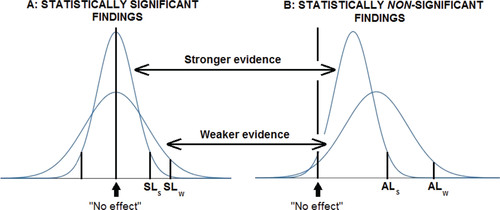Figures & data
Fig. A1 Under AnCred, statistically significant claims summarized by 95% CIs are subjected to fair-minded skeptical challenge represented by a prior distribution centered on no effect, whose 2.5% and 97.5% quantiles represent the critical prior interval. Weak evidence for the existence of an effect leads to relatively high skepticism limits (SLs), giving plenty of scope for skeptical challenge using prior knowledge. Strong evidence, in contrast, leads to tight CPIs, making skeptical challenge more demanding.

Fig. A2 The advocacy prior distribution for assessing claims of statistical nonsignificance summarized by 95% CIs. For substantive hypotheses of a positive effect, the lower bound of the advocacy CPI is fixed at no effect, while the upper bound—the advocacy limit (AL)—is such that the CPI encompasses 95% of the prior distribution capable of making the finding credible evidence of a positive effect. Weak evidence against such an effect—that is a broad, nonsignificant 95% CI with a lower bound pointing to a small negative effect—leads to a relatively broad CPI, as such findings put little constraint on the prior evidence needed for credibility. Stronger evidence against the substantive hypothesis leads to a tighter CPI, thus constraining advocates to a narrower range of prior support.

Fig. A3 The effect of prior evidence summarized by the interval (Lo, Uo) on the credibility of findings from different studies. For statistically significant findings (A), if Lo > SLw then the finding is credible evidence of a positive effect whether it came from the stronger or weaker study. If SLs < Lo < SLw, only the finding from the stronger study achieves credibility under AnCred. If Lo < SLs then demonstration of the credibility of the finding requires a Bayesian analysis specific to the study and prior evidence. For statistically nonsignificant results (B), findings still provide credible evidence of a nonzero effect if both Lo and Uolie between no effect and ALs in the case of the stronger study, and ALw for the weaker study. As before, the impact on credibility of prior evidence lying outside these ranges can be assessed using a specific Bayesian analysis.

